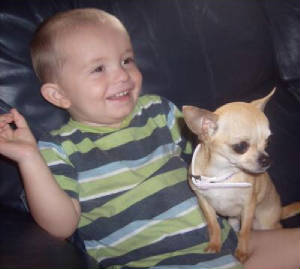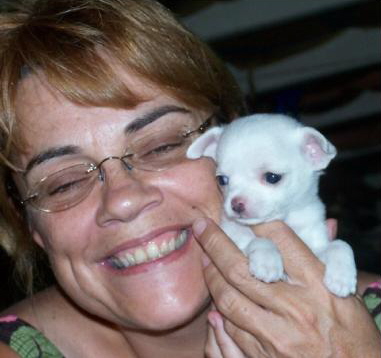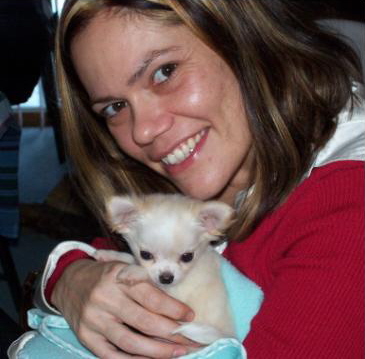Our puppies are fun, loving, curious & social, not afraid. They are raised in our kitchen, under foot &
are already starting to “feel their oats” as in a big dog in a small package. They are also offered short play
periods outside starting around the age of 8 weeks old. All puppies are around mounds of different types of toys & other
safe objects making learning a shear enjoyment. They certainly are accustom to different typical noises such as a dishwasher,
vacuum, car, lawn mower & ect. at our home.
All puppies at Envi Chihuahuas have had dew claws removed, vaccinations are always current, several wormings with a
negative fecal test, started on heartworm preventative, free of fleas or ticks & have been examined by our Florida Licensed
Veterinarian & have a written health certificate. Please see PUPPY CONTRACT.
We Feed and Recommend Eukanuba Small Breed Premium Puppy Food
&
NuVet Plus
| CLICK HERE FOR MORE INFORMATION |

|
| CLICK HERE TO ORDER |
All puppies come with at least a 1 week supply of Eukanuba Small Bite Puppy Food & NuVet Plus. We recommend that
you keep them on this diet for at least 6 months. If you choose to change their food, please WAIT until puppy has settled
in comfortably to his/her new home & follow the recommendations below.
Directions
For Changing Brands of Puppy Food
1)
Mix food ¾ of current food &
¼ of new food & feed for 3-5 days.
2)
Mix food ½ of current food &
½ of new food & feed 3-5 days.
3)
Mix food ¼ of current food &
¾ of new food & feed 3-5 days.
4)
Switch over to all new food.
Puppies are started on pee pad training before they go to their new homes. Most do very well, but on occasion it takes
a small amount of positive reinforcement to get them back on-track in their new home. We highly recommend only positive
training. Praise for attaining what is expected of them is the very best form of positive pee pad or outside training.
NEVER put a puppy's nose in its urine or stools and NEVER swat with a paper.
Socialization is key to a friendly and well-adapted puppy. Check your local dog clubs for a puppy kindergarten class.
Once puppy vaccines are complete, start bringing your puppy for visits at friends, ball games, pet stores, ect.
When you cannot supervise your puppy, we recommend that you have a puppy playpen of some sort to leave your puppy in
while away. There should be enough room for a small bed and an area for food, water & a pee pad. You are always welcome
to contact us for different ideas. Remember that putting the puppy in the kitchen; bathroom or other room of the house is
not necessarily a safe place. There are always electrical outlets, wood trim, plants, ect. that can be hazardous to your puppy's
health.
| MY GRANDSON KADEN |

|
| BA BA LOVES XELLA! |
SHIPPING
Shipping is available
when the puppy is old enough to endure the flight safely, which is usually at 12 weeks of age. Shipping price’s start
at $300 and price is always subject to change. This includes an Airline Approved crate, Health Certificate required for travel,
transportation of puppy to the nearest major airport & Airfare.
We also have hand
delivery available to your nearest major airport (USA ONLY) for $395. It is $350 for the transport & $45 for gas, tolls
& parking to Orlando for us to drop your puppy off. This offers your puppy a less stressful flight as the puppy is
transported with a person taking care of him/her on the airplane. Please ask for details.
Puppies that are to be shipped will be well adapted to a crate & car
rides prior to shipping. This definately helps reduce the stress of travel.
|
 |
 |
 |
We love having puppies
to play with!

|
| THERE IS LOVE IN THIS LIFE! |
Hypoglycemia in Puppies
If you puppy
(toy breed) isn't eating then you can try feeding some Nutri-Cal off your fingers. It is a malt paste filled with vitamins
and sugar designed to be highly palatable to your dog. This can be purchased at any pet store.
If you see
the symptoms listed especially lethargy, weakness or listlessness then your puppy may be suffering from hypoglycemia commonly
know as a “sugar drop”.
Symptoms of Canine Hypoglycemia
Symptoms
of hypoglycemia in dogs include:
·
Stupor, disorientation, reduced level of consciousness
*
Coma
* Seizures
* Weakness
* Lethargy
* Severe depression
It is very important to treat this condition ASAP as it could result in seizure
and collapse. Often just a dime size of some Karo syrup or honey rubbed onto the puppy’s gums is enough to treat the
“sugar drop”.
Sometimes there is more to hypoglycemia than just low
blood sugar. While being extra small and extra young is enough to drop one’s blood sugar, sometimes there is more to
the story. Any time Nutri-Cal, Honey or Karo Syrup does not treat the “sugar drop” within approx. 5-10 minutes,
get your puppy to your Veterinarian ASAP!
Parasitism/Diarrhea/Stress from any cause increases the
body’s demand for sugar. This is why it is especially important to insure the general health of the toy breed puppy.
When stressors are present, maintaining a healthy blood sugar level is all the more difficult. A new change of puppy’s
home is definitely NOT a good time to change its diet. After a hypoglycemic episode, it is important to watch food intake and be aware of any changes
in energy level. As the puppy gets bigger, risk factors diminish. Teeth get stronger, body fat stores develop, and the immune
system matures. Eventually, hypoglycemia risks become minimal and the puppy will continue life as any other puppy, playing
& chewing things up…
SOCIALIZATION
Socialization
is very important for a Chihuahua puppy. What socialization is not: strangers & visitors coming to your home = home turf.
It is not rides in the car or going new places like a baby in a bag. Socialization is: Getting out of your home & to new
place your puppy has not seen. Your puppy should be down on the floor & on a leash. You should always be watchful of your
environment so your small puppy does not get hurt. Encourage strangers to pet or hold your puppy with your supervision &
judgment. The more you do this, the more social & accepting of strangers your puppy will be. The ages of 12 weeks to 1
year old are crucial. This should definitely be started at 12 – 14 weeks of age. Socialization neglect can often be
irreversible!
|
 |
 |
 |
| CLICK HERE FOR MORE INFO FROM AKC |

|
PET HEALTH INSURANCE
Dogs who have been registered with the AKC are eligible for the Complimentary
60-Day Trial AKC Healthcare Plan. The plan is available up to 28 days after AKC registration.
| MY DAUGHTER, ALEASHA. |

|
| ALEASHA HAS FAITH! |
Vaccination Recommendations for Puppies (Puppy Shots)
Drs. Foster & Smith, Inc. |
|
|
|
The vaccination of puppies (puppy shots) is one of the crucial steps in assuring the puppy will have a healthy and
happy puppyhood. The who, what, why, when, where, and how of vaccinations are complicated, and may vary from puppy to puppy.
Always consult with your veterinarian to determine which vaccines are appropriate for your puppy. To better understand vaccines,
it is important to understand how the puppy is protected from disease the first few weeks of its life.
Protection from the mother (maternal antibodies)
A
newborn puppy is not naturally immune to diseases. However, it does have some antibody protection, which is derived from its mother's
blood via the placenta. The next level of immunity is from antibodies derived from the first
milk. This is the milk produced from the time of birth and continuing for 36-48 hours. This antibody-rich milk is called colostrum. The puppy does not continue to receive antibodies through its mother's milk. It only receives antibodies until it is two
days of age. All antibodies derived from the mother, either via her blood or colostrum is called maternal antibodies. It must
be noted that the puppy will only receive antibodies against diseases for which the mother had been recently vaccinated against
or exposed to. As an example, a mother that had NOT been vaccinated against or exposed to parvovirus would
not have any antibodies against parvovirus to pass along to her puppies. The puppies then would be susceptible to developing
a parvovirus infection.
Window of susceptibility
The
age at which puppies can effectively be immunized is proportional to the amount of antibody protection the puppy received
from its mother. High levels of maternal antibodies present in the puppies' bloodstream will block the effectiveness of a
vaccine. When the maternal antibodies drop to a low enough level in the puppy, immunization by a commercial vaccine will work.
The
antibodies from the mother generally circulate in the newborn's blood for a number of weeks. There is a period of time from
several days to several weeks in which the maternal antibodies are too low to provide protection against the disease, but
too high to allow a vaccine to work. This period is called the window of susceptibility. This is the time when despite being
vaccinated, a puppy or kitten can still contract the disease.
When should puppies be vaccinated?
The
length and timing of the window of susceptibility is different in every litter, and even between individuals in a litter.
A study of a cross section of different puppies showed that the age at which they were able to respond to a vaccine and develop
protection (become immunized) covered a wide period of time. At six weeks of age, 25% of the puppies could be immunized. At
9 weeks of age, 40% of the puppies were able to respond to the vaccine. The number increased to 60% by 16 weeks of age, and
by 18 weeks, 95% of the puppies could be immunized.
Almost
all researchers agree that for puppies and kittens, we need to give at least three combination vaccinations and repeat these
at one year of age.
Drs.
Foster and Smith prefer to vaccinate puppies with a combination vaccine at six weeks of age initially, with boosters given
every three weeks until the puppy is about sixteen weeks of age. We feel that this schedule will help protect the widest range
of dogs. We realize that with our protocol, we will be vaccinating some dogs that are not capable of responding, and we will
be revaccinating some dogs that have already responded and developed a protection. But without doing an individual test on
each puppy, it is impossible to determine when the puppy's immune system will be best able to respond. We also realize that in the face of an infection, due to the window of susceptibility,
some litters will contract a disease (e.g., parvo) despite being vaccinated. By using quality vaccines and an aggressive vaccination
protocol, we can make this window of susceptibility as small as possible. Our vaccination protocol may not be right for every
puppy. Puppies that are not exposed to other dogs and have a very small chance of coming in contact with parvovirus, may not
need to be vaccinated as frequently. At the same time, some 'high risk' puppies may need a more intense and aggressive vaccination
program. It is best to work with your veterinarian on a vaccination protocol that is best for your individual puppy or kennel,
taking into consideration your individual situation.
|
Consult with your veterinarian to determine which vaccinations your puppy should receive, and how often. |
|
| Puppy Vaccination Schedule |
| Age |
Vaccination |
| 5 weeks |
Parvovirus: for puppies at high risk of exposure to parvo, some veterinarians
recommend vaccinating at 5 weeks. Check with your veterinarian. |
| 6 & 9 weeks |
Combination vaccine* without leptospirosis.
Coronavirus: where coronavirus
is a concern. |
| 12 weeks or older |
Rabies: Given by your local veterinarian (age at vaccination may vary according
to local law). |
| 12 & 15 weeks** |
Combination vaccine
Leptospirosis: include leptosporosis
in the combination vaccine where leptospirosis is a concern, or if traveling to an area where it occurs.
Coronavirus:
where coronavirus is a concern.
Lyme: where Lyme disease is a concern or if traveling to an area where
it occurs. |
| Adult (boosters)§ |
Combination vaccine
Leptospirosis: include leptospirosis
in the combination vaccine where leptospirosis is a concern, or if traveling to an area where it occurs.
Coronavirus:
where coronavirus is a concern.
Lyme: where Lyme disease is a concern or if traveling to an area where
it occurs.
Rabies: Given by your local veterinarian (time interval |
 |
 |
|
|
|

